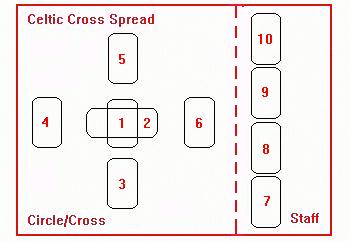Description
The Celtic Cross is probably the oldest and most popular pattern for reading the tarot. It has survived so long because the layout of the cards is simple, but powerful. A strong energy has built up around this spread due to its use by so many people over the years.
You can think of the Celtic Cross as divided into two sections: the Circle/Cross (six cards) on the left, and the Staff (four cards) on the right. (See diagram above.) The Circle/Cross simulates the Celtic cross found throughout Ireland. This cross has a circle linking the four perpendicular spokes. The circle and cross symbolize the joining of spirit and matter and the unity of all events in time.
The feminine energy of the circular section works in unison with the masculine energy of the Staff section. These two parts of the Celtic Cross mirror the dual nature of manifested reality - the polarities that abound in the human psyche.


The Circle/Cross section is made up of two crosses - a central one (two cards) nested within a larger cross (six cards). The smaller cross represents the heart of the matter - what is most central to you at the time of the reading. It is the hub around which the wheel of your life is turning.
The larger cross consists of two lines that overlay the minicross. The horizontal line (H) shows time moving from your past on the left into your future on the right. The vertical line (V) is your consciousness moving from your unconscious on the bottom to your conscious mind on the top. Together these six cards give you a snapshot of the energies involved at the time of a reading.
The cards of the Staff section comment on your life and lie outside of the immediate situation. Here, your Inner Guide helps you understand what is shown in the Circle/Cross section. You receive guidance about yourself and others, your life lessons and your future direction.
There are a number of versions of the Celtic Cross. The differences are usually in cards 3-4-5-6. I use a clockwise placement to emphasize how the unconscious and the past (Cards 3 and 4) lead to the conscious and future (Cards 5 and 6). I have also added some meanings to Card 9. This position traditionally means "hopes and fears," but I also use it as a lesson or guidance card. It is always possible to adapt a spread to your own needs as long as you decide on any changes before you do a reading.
Interpretation
Here is one approach to interpreting the Celtic Cross.
- Look at the six cards of the Circle/Cross section. They show what is going on in your life at the moment of the reading.
- Examine the cards in pairs, perhaps in the following order:
- Look at Cards 1 and 2 to find out the central dynamic.
- Look at Cards 3 and 5 to find out what is going on within you at different levels.
- Look at Cards 4 and 6 to see how people and events are flowing through your life.
From these six cards, create a description of your immediate situation.
- Consider the Staff section of the spread, perhaps in this order:
- Look at Cards 7 and 8 to find out how more about the relationship between you and your environment.
- Look at Card 10 - the projected outcome. How do you feel about it? What does it say to you?
- Review the cards to discover the factors leading to the outcome. See if one card stands out as key. Also:
- Compare the projected outcome (Card 10) to a possible alternative outcome (Card 5).
- Consider how the near future (Card 6) contributes to the projected outcome (Card 10).
- See if Card 9 tells you something you need to know. Do you have a hope or fear that is relevant?




